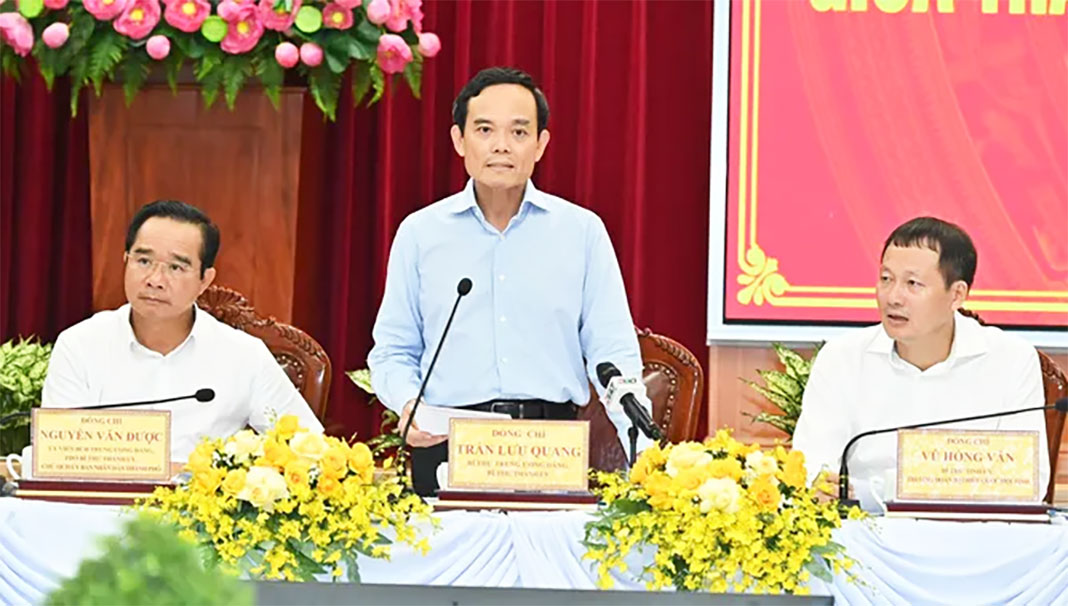HCMC – Party Secretary of HCMC Tran Luu Quang today, October 21, led a working delegation of the city to neighboring Dong Nai Province for a meeting with the provincial Party Committee’s Standing Board to discuss transport infrastructure connectivity between the two localities.
Co-chairing the meeting were Vu Hong Van, secretary of the Dong Nai Party Committee, and key leaders of the provincial Party Committee and People’s Committee.
This was the first such meeting between top leaders of HCMC and Dong Nai after the recent provincial mergers, taking place amid the implementation of several major infrastructure projects of strategic importance running through both localities.
In his opening remarks, Van said Dong Nai was honored to welcome the HCMC delegation for discussions on infrastructure connectivity that would drive the development of both localities and the nation’s entire southeastern region.
Speaking at the meeting, HCMC Party Secretary Tran Luu Quang underscored the need for stronger cooperation for joint development between the two localities to create a seamlessly connected development space.
He asked participants to engage in in-depth discussions, address issues directly, and propose practical solutions and concrete plans to remove major bottlenecks in the implementation of transport connectivity projects between the two localities, particularly in site clearance and compensation.
Party leader of Dong Nai Province Vu Hong Van said that following the first Congress of the Dong Nai Province Party Committee in the 2025-2030 term, Dong Nai identified key tasks, including developing a synchronized transport infrastructure network and enhancing connectivity with the megacity of HCMC.
Home to the Long Thanh International Airport, Dong Nai serves as a dynamic growth pole in southern Vietnam. Van stressed that if the province failed to seize the moment, it could lose valuable development opportunities. He expressed hope that the two sides would reach clear, coordinated roadmaps to ensure consistency in transport infrastructure planning and development.
The development of the Long Thanh airport area, coupled with the transport system linked to seaports and logistics services, would create growth momentum of international significance, Van added.
According to Van, the meeting focused on two key topics: aligning the responsibilities of each locality in implementing transport infrastructure projects, and identifying additional long-term connectivity routes.
According to reports presented at the meeting, after HCMC’s transformation into a megacity, the transport infrastructure network connecting HCMC and Dong Nai has expanded significantly, with ongoing and planned large-scale projects.
Currently, there are 45 roads connecting the two localities, including beltways, expressways, and national highways. Of these, 14 are already operational, 13 are under construction, and 18 are being studied for investment.
The rail network has five planned routes: the Ben Thanh–Suoi Tien metro line extension to Dong Nai, the Ba Ria–Vung Tau urban railway (Line No. 3), the Bien Hoa–Vung Tau national railway, the Bau Bang–Cai Mep national railway, and the Thu Thiem–Long Thanh national railway.
Waterway transport between the two localities has 12 river passenger terminals, mostly along the Dong Nai River.
In addition, HCMC and Dong Nai currently operate nine interprovincial bus routes and 79 coach routes providing daily passenger transport services.
Before today’s meeting, leaders of HCMC and Dong Nai had reached preliminary consensus on the necessity of investing in key infrastructure projects such as the Cat Lai Bridge that would replace the current ferry service, Phu My 2 Bridge, Dong Nai 2 Bridge, and an express railway linking the current Tan Son Nhat International Airport and the under-construction Long Thanh International Airport.
The HCMC and Dong Nai people’s committees have assigned the HCMC Department of Construction to coordinate with its Dong Nai counterpart and relevant agencies to establish a joint task force for implementation of transport connectivity projects.
The task force will be responsible for formulating regulations, defining functions, setting operational plans, and prioritizing highly feasible projects. It will also outline key projects for the 2026–2030 period to ensure consistent coordination under the direction of both sides’ leadership.









